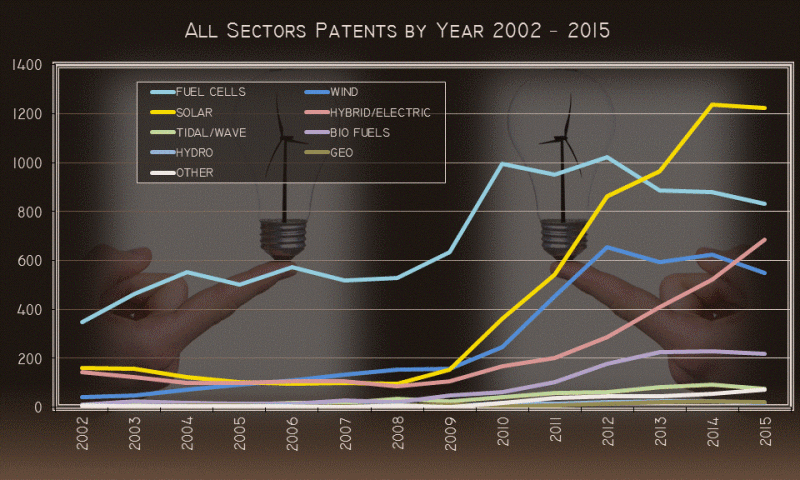
Whether it involves carbon emissions, waste management, electricity consumption, or other business activities impacting environmental aspects, eco-innovation can provide a great path for easier, more widespread, cost-effective ways to minimize companies’ environmental footprint. Green innovation can lead to long-lasting and positive change when it comes to our environmental impacts. It can start in a variety of sectors: from 3D printing, to battery storage, to vertical farming, and more.
Patents, and in particular green patents, can be a strategy used by companies to create more sustainable business opportunities for clients and stakeholders, while incentivizing environmentally-friendly business practices. Currently, many regional and global databases exist to search green patents. EcoVadis strives to integrate green innovation into its Corporate Social Responsibility (CSR) assessments by rewarding companies with green patents and promotes their use as well as environmentally-friendly innovation.
Green patents are patents on products or designs that result in tangible environmental benefits. Key areas of innovation include energy efficiency, alternative fuels, wind, solar, tidal/wave and nuclear energy, waste recycling, material efficiency, biomimicry, and more. Green patents can help incentivize innovation in eco-friendly businesses and increase profit margins in companies that have designed new innovative solutions.
Growth of Green Patents
The past few years have seen a large increase in the number of green technologies registered with patent offices around the world. The granting of patents by the United States Patent and Trademark Office (PTO) is often referred to as an indicator for cutting edge innovation and efficient R&D investment among companies.
The Clean Energy Patent Growth Index (CEPGI), which has been tracking green patent trends since 2002, has reported upward trends of green patents in economies around the world, such as Germany, Japan, Korea, and Taiwan, as well as in the United States, including in Michigan, California, and Texas. Additionally, every type of green technology patent tracked by the CEPGI has seen steady increases in numbers since 2002. Many of these patents focus on alternative or renewable energy sources, such as wind, solar, tidal, wave, biomass/biofuels, hydroelectric, geothermal, fuel cells, and hybrid electric vehicles and/or biomimicry.
The largest number of green patents was in solar technology, with 1238 solar patents, a 28% increase from the previous year. Fuel cell patents were in second place, with 1024 (a 27% jump from 2013), followed by wind patents (623), and hybrid/electric vehicle patents (521). Biofuels patents (230) were in the fifth position.

Source: CEPGI
A separate report by the World Intellectual Property Organization (WIPO) shows a 24% annual growth in Climate Change and Mitigation Technologies (CCMTs) between 2006 and 2011, highlighting emerging innovations in biofuels, solar thermal, solar PV, and wind energy.
Green patents are used by the OECD as a key indicator to measure the effectiveness of national policies in delivering green growth.
Geographical Differences
Intellectual property regimes, particularly patent laws, are important regulatory vehicles that promote technological innovation. In recent years, many countries have sponsored green patent programs for proprietary ideas that have both significant ecological and commercial value. Geographical differences are most notable with the growth in innovation from West to East. China and the Republic of Korea have filed the most patents in recent years across all four technology areas (biofuels, solar thermal energy, solar PV, and wind), while the top 20 technology owners of solar PV are all based in Asia. In China alone, environmental technology patents applications increased by 1040% from 2000 to 2011, whereas the increase is 611.5% for all patent applications.
Global Green Patent Databases
Due to the increasing popularity and interest in green patents globally, specific databases are increasingly being used to register and search for green patents. These patent databases allow individuals and organizations to gain financial value from green innovations, while providing interested parties with a platform to seek out and learn from technologies that can have positive impacts on the environment.
Some of the more prominent green patent databases are: US Patent & Trademark Office, European Patent Office, UK Intellectual Property Office, China Patent Office Database, Japan Patent Office, as well as international databases such as EspaceNet and the World Intellectual Property Organization-Green.
In line with United Nations plans to accelerate green technologies globally, seven countries, including the UK, Australia, and Canada, have introduced fast-track patent programs over recent years. More specifically, some patent offices, such as the US PTO and UK IPO, have introduced an accelerated review of green technology patents to help speed up the approval process and implementation of patents associated with positive environmental impact.
Green Patent Distribution by Sectors
In terms of green innovation, while most sectors have the potential to generate, invest in, or use green patents, certain sectors inevitably have a larger stake in the creation or acquisition of patents. EcoVadis’ research identified six key sectors that have high involvement in green patents and innovation: agriculture, forestry and fishing; mining and quarrying; manufacturing; electricity, gas, steam, and air conditioning supply; water supply, sewerage, waste management, and remediation activities; and construction. However, with the growing relevance of environmental management systems for companies across all sectors, green patents can potentially be relevant for all companies across all sectors. There are constantly new ways for companies to learn about green patents and how it can play a role in their sector. Eco-Patent Commons is an organization launched by a collaboration of IBM, Nokia, Pitney Bowes, Sony, the WBCSD, and the Environmental Law Institute. Their goal is to provide a platform and opportunity for organizations and companies to share their innovations and interests in environmentally-friendly technologies while also encouraging deeper synergies.
A Few Examples
In 2012, Toyota topped the list for overall and green tech patents. In 2015, Toyota was identified by CEPGI as winner of first quarter of 2015 and all of 2014 for having the greatest number of green energy patents. In the 2nd quarter of 2015, Toyota once again led the field with total number of patents, earning 24 new patents for hybrid/electric vehicle technology, while also being granted 16 fuel cell patents and one solar patent. Additionally, in 2015 Toyota announced that it will offer all 5680 fuel cell patents royalty-free to the public to help advance fuel cell technology.
Another interesting example comes from Solidia Technologies, Inc., a company that develops processes for more environmentally-friendly building products, while also specializing in more environmentally-friendly manufacturing, such as production of materials at low temperatures and pressures. Solidia Technologies teamed up with Rutgers University to create a type of concrete that can cure and harden by absorbing CO2 instead of water, a product that works on minimizing water consumption and reducing existing CO2. With concrete demand increasing at an unprecedented rate due to globalization and larger needs for construction, this breakthrough could really help reduce GHGs – specifically the carbon footprint of concrete could be reduced by up to 70%.
Contributors:
Jasmin Aswani, Maureen Loman and Jonathan Sim, CSR Analysts at EcoVadis
Continue reading:
5 Key Factors in Choosing a Supplier CSR Monitoring Solution

